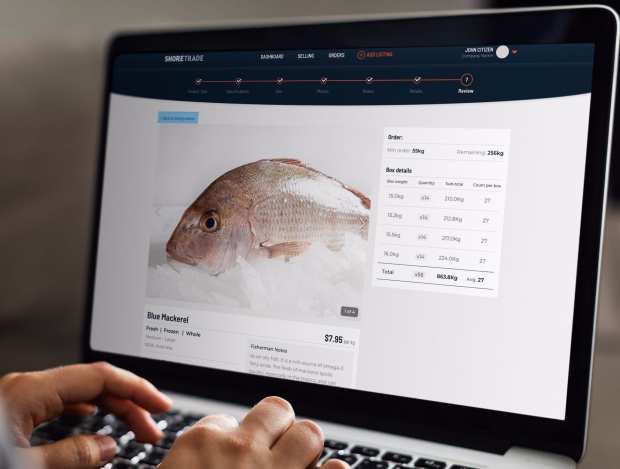ShoreTrade On Reducing Risk By Implementing Speedy B2B Payments

The seafood supply chain is undergoing a sea change worldwide — with sellers no longer willing to accept standard 90-day payment terms. In the Global B2B Payments Playbook, Mark Esterhuizen, chief operating officer at digital seafood platform ShoreTrade, explains how digital B2B payments are pushing buyers in the space to adapt as vendors seek options that reduce late payment risks.
The fishing industry is centuries old and steeped in tradition and may not be where one would expect innovation and evolution to reduce risk. B2B online seafood trading platform ShoreTrade saw where the currents were shifting and came onto the scene two years ago to help fishermen directly sell their daily catches to end buyers. CEO Peter Manettas, member of a fourth-generation fishing family in Australia, launched the company to simplify and shorten a classically long and slow supply chain, getting fish from boats to consumers’ plates more quickly while getting money to fishermen faster.
Anglers and fisheries can list and sell their catches on the marketplace directly to buyers locally and around the world. The company’s mobile app empowers users to find products they want, giving details about the catch and even sharing fisherman notes for added transparency.
“What [Manettas] saw at that time was a massive role and an opportunity within the B2B space in terms of simplifying and shortening the supply chain,” Mark Esterhuizen, ShoreTrade’s chief operating officer, said in a recent PYMNTS interview. “The idea was to get product from boats to plates a lot quicker as well as matching consumer demand and trends.”
ShoreTrade has facilitated trades across Australia, China, Japan, New Zealand, the United States and Hong Kong and is expanding into additional countries like Norway, Malaysia, Vietnam and other southeast Asian nations. Esterhuizen said the company is not only able to assist trade between stakeholders across the supply chain but also offer end-to-end logistics to ensure freshness during transportation and delivery. Anglers can sell into multiple markets as a result, and ShoreTrade engineered a reverse marketplace initiative where buyers can request products as well.
Implementing B2B Payments To Reduce Risk
The company designed its ShorePay financing tool to relieve payment-related challenges for both sides of the marketplace. Buyers are traditionally slow payers, but ShorePay allows for similar payment terms for buyers while reducing the time it takes sellers to get paid from 90 days to within 24 hours from the delivery date. Increased payment speed was met with various responses, though these were mostly positive due to the working capital assistance provided to both sides of the marketplace. Some buyers resisted due to being confined to defined payment terms, however. The combination of buy now, pay later, Laybuy, invoice factoring and reverse factoring services and products has been a game-changer for the old-world industry.
“There was resistance because people are like …‘I don’t want to be paying within seven to 14 days.’…Buyers have to be faced with the reality check … If they’re not willing to play by the rules with regards to payment terms, they’re never going to get access to suppliers and supply because the suppliers now are moving towards our channel because of the speed of payments,” he said.
Esterhuizen acknowledged the new rules necessitated some forced adoption in an old B2B space. The sudden, acute need to shift to faster B2B payment tools reflects recent research that gathered data from the United Kingdom and U.S. senior decision-makers and found that 27 percent of consumers exceed their payment terms, harming businesses’ cash flows.
“[ShorePay] increases [the] velocity of purchase across platforms,” Esterhuizen said. “It allows buyers, who are capital-constrained, to have access to and purchase more products.”
ShorePay created its own payment tool because banks do not know how to provide credit to these customers because they lack understanding about how the product moves through the supply chain, he said. “They don’t know how to underwrite risk and they don’t understand the key nuances of the industry.”
Pandemic-Driven Industry Shifts
The pandemic has massively impacted the fishing industry. Traditional distribution channels would ship the product as many as five times to different hands before it made its way to the marketplace, where it would then be bought by a wholesaler, retailer and then by a consumer. These traditional channels and supply distribution measures seemingly disappeared after the pandemic struck, resulting in sellers wanting to reach the consumer segment directly as the demand for home deliveries surged. The supply chain shifted focus from providing fish to large wholesalers to retailers because they were closer to their consumers.
“We didn’t necessarily see a drop in volume, [but] we just saw a shift in volume across the segments,” Esterhuizen said. “Home delivery partners then popped up in terms of getting product to retailers. ShoreTrade addressed issues through our distribution, our breadth of buyer and our ability to move product across borders, within states and touch various different segments of the markets.”
The pandemic challenges have changed the B2B space as demand for improved cash flow remains a high priority among fisheries and throughout many other industries. Adopting or creating innovative, speedy B2B tools as ShoreTrade has will help reduce risk and modernize legacy practices.

